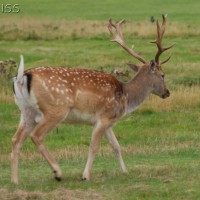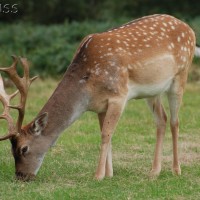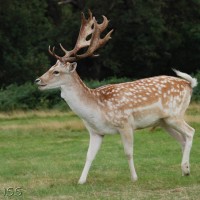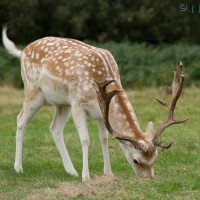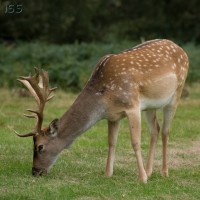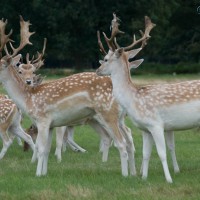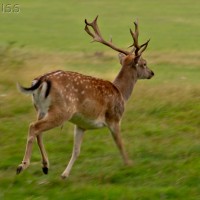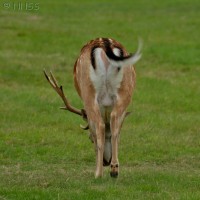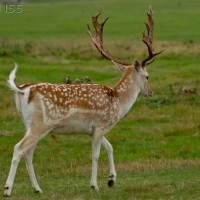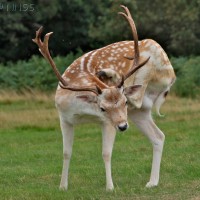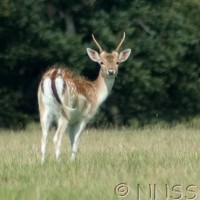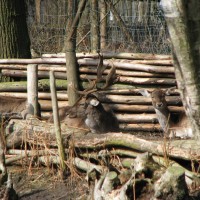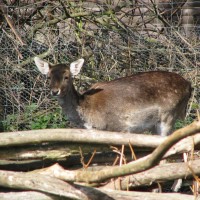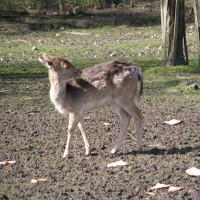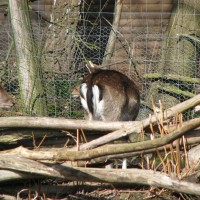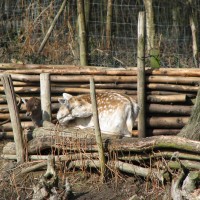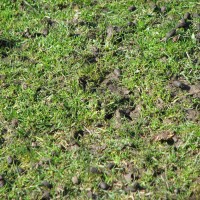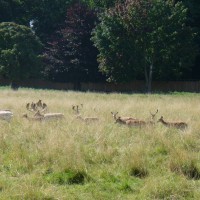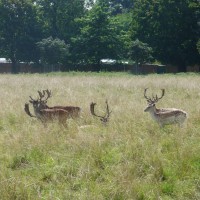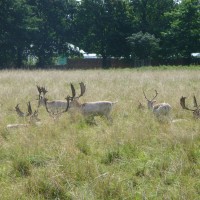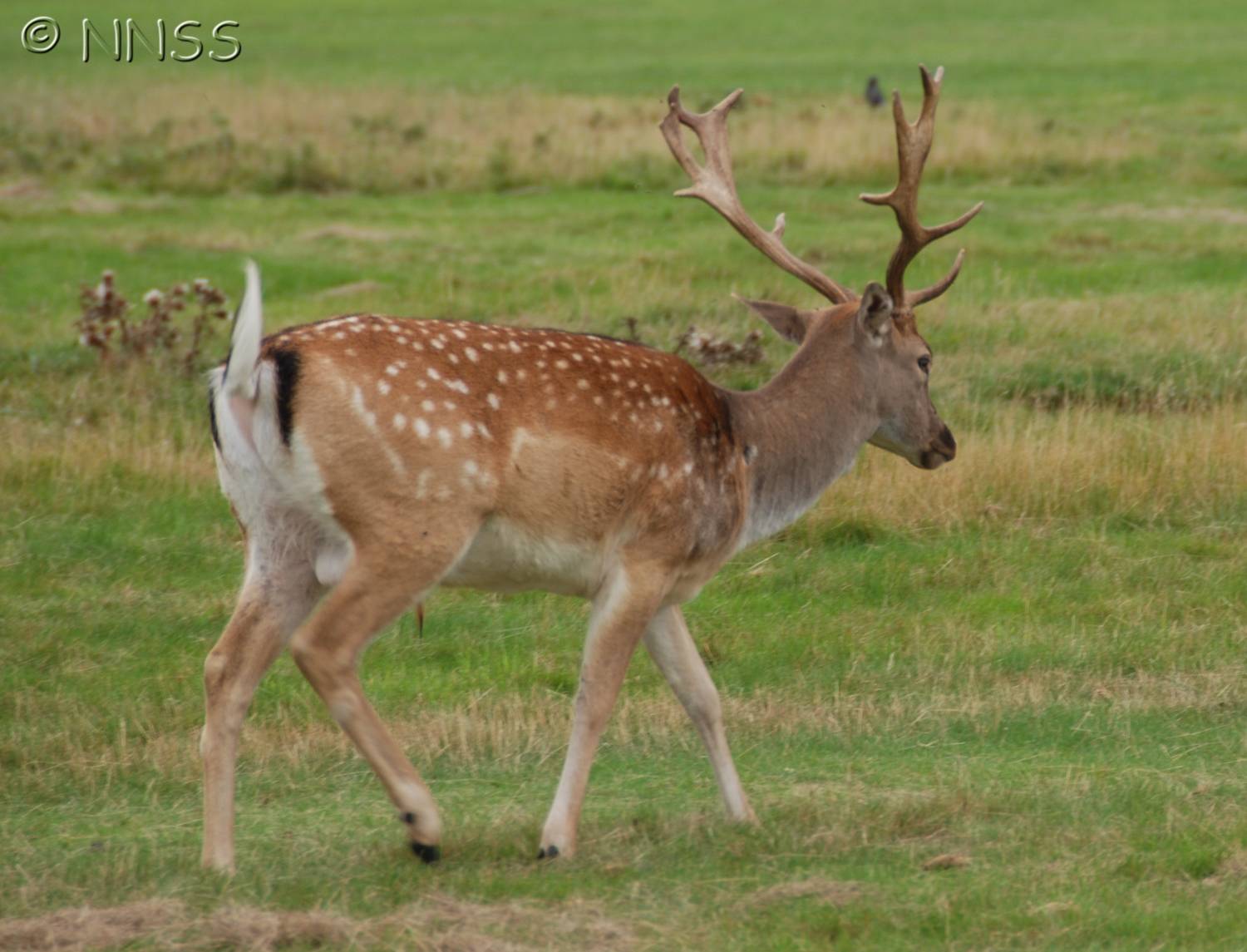
Fallow Deer - Dama dama
Expand and collapse the sections below by clicking on the title or + / - icons.
Short description of Dama dama, Fallow Deer
This deer is intermediate in size between red deer and roe deer, with a distinctive pattern on the hindquarters: there is a heart-shaped white area with a blackish upper margin which, combined with the blackish upper surface to the tail, forms an inverted anchor shape. The pelage pattern is variable but usually there is prolific pale spotting on the back and flanks. All-white and all-dark animals are not infrequent. Mature bucks have distinctive flattened (palmate) antlers, edged with short, pointed prongs.
Impact summary: Dama dama, Fallow Deer
The fallow deer is perhaps the most numerous of GB's introduced deer species and has major negative impacts on forestry, agriculture and native biodiversity.
Habitat summary: Dama dama, Fallow Deer
Fallow deer occupy a wide variety of habitats and climates across Europe but avoid alpine and Arctic conditions. Most are found in open woodlands.
Overview table
| Environment | Terrestrial |
|---|---|
| Species status | Non-Native |
| Native range | Southeastern Europe, Western Asia, Turkey |
| Functional type | Herbivore |
| Status in England | Non-Native |
| Status in Scotland | Non-Native |
| Status in Wales | Non-Native |
| Location of first record | New Forest |
| Date of first record | 1100 |
Origin
Fallow deer are native in Turkey and possibly also in Iran and in southeast Europe west to mainland Italy. They were introduced to the western Mediterranean by the Phoenicians and were brought to GB by the Normans, probably from Sicily.
First Record
Fallow deer were introduced in southern England soon after the Norman conquest, as recorded by the Domesday Book of 1086. The species has also been identified in remains at Fishbourne Roman Palace in West Sussex dating from the 1st century but it is not known whether these animals had been captive or living wild.
Pathway and Method
Fallow deer were introduced to the many hunting forests established in England, Wales and Scotland during the 11th and 12th centuries. Over subsequent centuries, many parks have held fallow deer herds for venison farming or for ornamental purposes, from which animals have escaped or been released into the wild.
Species Status
The fallow deer is patchily distributed, having strongholds in many southern and eastern counties of England and in north and south Wales and central Scotland. Its status as the most abundant introduced deer in GB is being challenged by the rise of muntjac. The species is also non-native in parts of North and South America, South Africa, Australia and New Zealand and is considered an invasive pest in some of these regions.
Dispersal Mechanisms
Herds are generally faithful to a well-defined home range. Fallow deer have been very slow to disperse away from their points of introduction and the range in GB has changed little over many centuries. Subpopulations with distinctive pelage characteristics occur within the main range.
Reproduction
During the rut in October–December, the bucks defend a rutting stand or search for receptive females. Does give birth to a single fawn, usually in June or July. Yearling does can breed when conditions are suitable.
Known Predators/Herbivores
Fawns are vulnerable to dogs and foxes but adult animals have no native predators in GB other than man.
Resistant Stages
None.
Habitat Occupied in GB
Herds of fallow deer are seen mostly in parkland habitats with rich grassland and standard trees or woodland patches.
The distribution of fallow deer is incomplete but fairly wide across England and Wales but much more patchy in Scotland, where they occur on the islands of Islay, Scarba and Mull as well as at a few mainland localities.
Environmental Impact
Browsing of tree shoots and undergrowth by deer results in radical change to the structure of woodland, with consequent negative effects on other elements of the woodland ecosystem. For example, loss of bramble cover reduces habitat for woodland rodents and for small birds, including Nightingale. Grazing by deer reduces the diversity of ground flora, with consequent negative effects on butterflies and other insects.
Health and Social Impact
Fallow deer are attractive animals that many people enjoy seeing in the GB countryside. Where they meet road traffic, however, human injury or death may result.
Economic Impact
Fallow deer, especially where they occur at high density, can cause economic damage to agricultural crops and to tree shoots by their grazing and browsing. Deer are an important and increasing cause of road accidents, resulting in economic losses to motorists. On the other hand, many country and forest estates can gather revenue from recreational stalking or the sale of venison and, at some localities, the presence of fallow deer may be a tourist attraction.
Identification
Harris, S. & Yalden, D.W. (2008) Mammals of the British Isles: Handbook. Fourth edition. The Mammal Society, Southampton.
Biology, ecology, spread, vectors
Ward, A.I. (2005) Expanding ranges of wild and feral deer in Great Britain. Mammal Review, 35, 165–173.
Management and impact
Putman, R.J. (1997) Deer and road traffic accidents: options for management. Journal of Environmental Management, 51, 43–57.
Putman, R.J. & Moore, N.P. (1998) Impact of deer in lowland Britain on agriculture, forestry and conservation habitats. Mammal Review, 28, 141–164.
Wilson, C. (2003) Current and future deer management options. Report on behalf of Defra European Wildlife Division. full text
General
Chapman, D. & Chapman, N. (1975) Fallow deer: their history, distribution and biology. Terence Dalton, Lavenham.
Chapman, N. (1984) Fallow deer. Anthony Nelson, Oswestry.
Langbein, J. & Chapman, N. (2002) Fallow deer. The Mammal Society, London and the British Deer Society, Fordingbridge.
Lever, C. (2009) The Naturalized Animals of Britain and Ireland. New Holland Publishers, London.
Long, J.L. (2003) Introduced mammals of the world: their history, distribution, and influence. CABI & CSIRO Publishing, Collingwood, Victoria.
Spotted this species?
Distribution map
View the Distribution map for Fallow Deer, Dama dama from NBN Atlas

